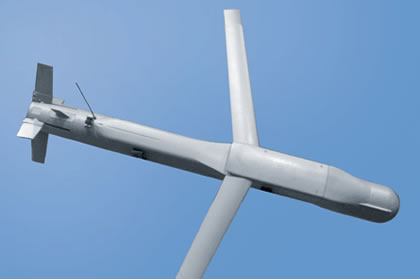The new 250 pound class bombs are designed to provide high precision and effective stand-off range when launched from fighter bombers or unmanned platforms. This type of weapon offers increased weapon’s loads on current bombers and strike fighters, as well as flexible loading options for future Unmanned Combat Aircraft Systems (J-UCAS).
SDB is designed to destroy a variety of targets, penetrate over 1.20 meters of steel reinforced concrete while inflicting minimum collateral damage, from ranges of 70km (40nm). The US Air Force plans to use these weapons with its fleet of F-15E, F/A-22, F-35 and unmanned combat air vehicles (UCAV). Current plans call for procurement of 24,000 SDBs and associated Diamond Back kits over the period 2005 – 2015. SDB will also offer extended range capability, utilizing standoff, precision attack gliding kits such as the Diamond Back, offered by MBDA. Other SDB enhancements include seekerless configurations, such as the Lockheed Martin PNAV.
September 8, 2006: USAF F-15Es recently received the new 250 pound Small Diameter Bomb I weapon, offering precision-guided accuracy within 1.2 meters of the aim point. The weapons are expected to equip the USAF 494th Fighter Squadron scheduled to deploys to Southwest Asia later this year. The squadron will be the first to use the Air Force’s new Guided Bomb Unit-39 bomb fitted with diamond-back wings that enable the weapon to glide to its target from a stand-off distance.
This high accuracy combined with a smaller warhead enables the fighters to achieve the effects while minimizing potential collateral damage. With the introduction of SDB I to the Air Force inventory, the Strike Eagle aircrews also benefit from increased weapon employment range. SDB I has a standoff range of up to 60 nautical miles in front of the aircraft, 40 miles to the left and right of the aircraft and can even turn around and attack targets behind the aircraft. Each SDB can be targeted at a specific target. Targeting programming can be done on the ground or updated while airborne, before release. All bombs can be targeted separately or directed to attack a single target, as required.
SDB I enables the Strike eagles to carry four weapons on every precision-guided missile weapon station; four weapons in place of one. The four-place carriage (BRU-61/A) developed and manufactured by the Boeing Team to carry SDBs virtually eliminates periodic maintenance and cleaning. It’s a pneumatically operated carriage versus the traditional, explosively operated carriage that fires a cartridge to release the weapon. After a number of firings, these current inventory carriages must be cleaned, a labor-intensive operation.
The US Air Force is developing a Focused Lethality Munition warhead for the Small Diameter Bomb. The new warhead employs multi-phase blast explosive and a composite carbon fiber warhead case, allowing for pinpoint strikes with low collateral damage. The FLM warhead technology was developed at the Lawrence Livermore National Laboratory and the U.S Air Force Research Laboratory. Under a US$27 million Joint Capability Technology Demonstration (JCTD) program contract awarded in September 2006, Boeing will incorporate the FLM technology into the SDB I system, perform a series of ground and flight tests, and manufacture a limited number of FLM weapons. Boeing is expected to deliver the first 50 weapons for operational assessment in January 2008, with the Air Force procuring as many as 450 SDB I FLM units through 2012.
The SDB family of weapons developed by Boeing has quadruples the number of weapons an aircraft can carry, enabling aircrews to attack more targets on each sortie. Boeing led the SDB-I team with Lockheed Martin, with Boeing acting as the prime contractor, supplying the air vehicle, a derivative of SDB I, as well as the network data link system. Lockheed Martin, is responsible for the multi-mode seeker system, derived from the Joint Air-to-Ground Missile (JAGM).
In April 2006 Boeing, teamed with Lockheed Martin and Raytheon won two U.S. Air Force contracts (about $145 million each) for the competitive risk reduction phase of the SDB II program. SDB II is designed to accurately hit moving targets under all-weather conditions. SDB II will be equipped with a tri-mode seeker comprising a millimetre-wave radar, imaging infrared (IIR) camera and semi-active laser (SAL) all integrated into a single system. In August 2010 the Air Force announced Raytheon as the winner, selecting the GBU-53B design for the future increment of SDB.
For the SDB II phase Raytheon has developed an all-new, streamlined bomb casing and folding swept-wing. Raytheon is developing a tri-mode sensor for this weapon, based on the dual-mode seeker employed in the Precision Attack Missile (PAM) missile and Army Medium Range Munition (MRM) programs.





















